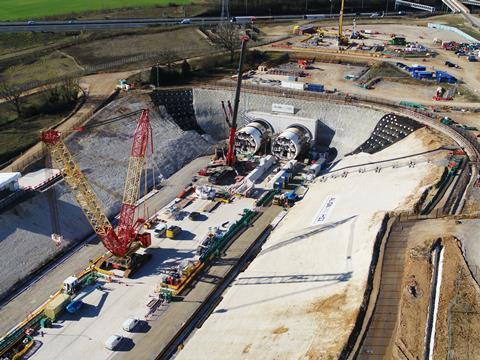
UK: The Align JV of Bouygues Travaux Publics, Sir Robert McAlpine and VolkerFitzpatrick has started to excavate HS2’s 16 km Chiltern tunnel using semi-continuous boring machines, in what it says is a first for a UK tunnelling project.
The first of two Herrenknecht variable pressure TBMs, named Florence, began its drive north from the launch site at South Portal near Rickmansworth on May 7, while the second, Cecilia, is expected to be launched from the same location before the end of June. They will be tunnelling for the next 3½ years to complete the longest of the twin-bore tunnels on the HS2 Phase 1 route between London, Birmingham and a junction with the West Coast Main Line near Lichfield.
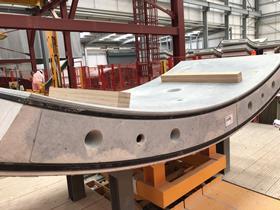
Speaking to Rail Business UK at South Portal on June 1, HS2 Ltd Senior Project Manager Mark Clapp explained that Florence was ‘already about 53 rings in’ to its drive. Each TBM will install rings made up of seven precast concrete segments produced at a factory and batching plant on site at South Portal. Each segment has its own barcode, enabling the use of BIM to trace its complete life cycle from the delivery of the raw materials through to installation in the tunnel.
Key to the objective of continuous operation is to increase the speed of the tunnelling, Clapp explained. To achieve this, the TBMs have been equipped with specialist ‘rams’ which enable the machine to position part of one lining ring while the rams are pushing the machine forward from the previous ring. The TBM can then switch to a second set of rams pushing against these initial segments while the rest of the ring is installed.

This parallel operating method means the TBM can keep moving forward all the time, instead of pausing at every ring to complete the installation of the segments. A crew of 17 people is needed to operate each TBM on two 12-hour shifts, supported by more than 100 staff on the surface providing logistical support.
Geological challenges
Almost immediately after launch, the TBMs must pass beneath the eight-lane M25 London orbital motorway, adjacent to the perimeter of the South Portal site. This will be one of the most delicate aspects of the tunnelling operation, with the tunnel crowns to be excavated approximately 9∙5 m below the road surface.
Final approval from the highway authority to proceed was only granted ‘a few weeks ago’, Clapp reported. Because of their staggered launch dates, only one TBM is expected to be active under the road at any time. Remote condition monitoring sensors have been fitted to the road surface and various traffic signal gantries to give an early warning of any ground movement.
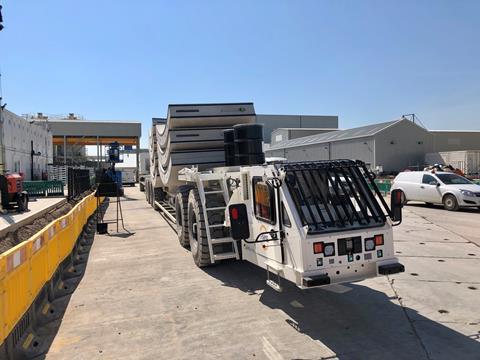
Recognising the wider challenges of burrowing through potentially tricky ground conditions, Clapp acknowledged that ‘we know we are going to encounter problems at some point’. The Chiltern hills are made up overwhelmingly of chalk, and prior ground investigation had already found fault lines and chalk aquifers. Among the novel features of the TBM is a bespoke Archimedes screw designed to transfer spoil, converted into slurry from the cutter head so that it can be pumped back to South Portal.
The Align JV is also at pains to stress that any risk to local water supplies from the tunnelling work is being minimised. ‘We’ve spent vast sums assessing the risk of disturbance to chalk aquifers’, Clapp emphasised. ‘We need to minimise the risk of water ingress to the excavation area.’
The alignment of the tunnel passes through an area of water collection known as Abstraction Zone 1, and this has been one of the topics highlighted by vociferous local critics of the HS2 project. However, Clapp felt confident that the stringent testing and monitoring regime being implemented by utility company Affinity Water and the Environment Agency would minimise any potential impact.
Slurry processing
As with most major tunnelling schemes, HS2 Ltd and Align face a significant challenge in managing the removal of slurry and spoil during the excavation process. Around 2∙6 million m3 of chalk is due to be removed in total. The material will be mixed with water before being pumped out as slurry using a series of pipes located behind the two TBMs.
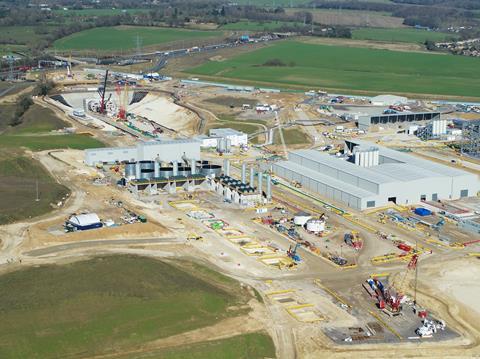
The slurry will be processed at what Align says is the largest treatment facility in Europe, also located within the South Portal site. The chalk and water will be separated and pressed through ever-finer filters until all the water has been removed to leave behind a dry chalky ‘cake’. One of the key challenges in the separation process is to prevent the thickening slurry from clogging up the filtering machinery. Working with its slurry processing plant supplier MS, Align will use a polymer specifically developed to be effective with Chilterns chalk, which should enable the entire separation process to be completed in around a week.
The dried chalk is to be used to support a rewilding programme at the South Portal site, known as the Colne Valley Western Slopes. This will see a former quarry landscaped before being seeded to grow around 90 ha of the locally distinctive calcareous grassland which existed before the agricultural revolution. The rest of the site will gradually return to grassland as the railway is completed, mirroring similar construction sites such as Beechbrook Farm in Kent, used as a base for the Channel Tunnel Rail Link in the 1990s.
Construction hub
With a perimeter of no less than 5 km, South Portal is not just a base for tunnelling, but a self-contained logistical hub underpinning much of the work required under Align’s C1 civils contract with HS2 Ltd.

At its heart is the U-shaped precast concrete tunnel ring batching and production plant, which is now in full swing producing the 112 301 segments required by the two TBMs. Nearby, a similar but larger factory will be responsible for the production of concrete elements for the 3∙4 km Colne Valley viaduct, located just to the south of the site.
The South Portal location has been developed with a view to minimising the impact on the local community of the construction process, especially that caused by heavy lorry traffic. The site is served by dedicated slip roads to and from the M25 motorway.
At the height of construction, South Portal and its satellite sites — such as those where tunnel ventilation shafts are being built — are expected to require 1 200 staff. A modular accommodation block has been erected to serve as a basic ‘hotel’ for those tunnelling staff who do not live locally to stay over at the end of a shift, in keeping with the European Working Time Directive.
Colne Valley viaduct
While Clapp saw the tunnelling work as ‘the critical path’ for the Align JV’s delivery objectives, early preparations are also underway for construction of the viaduct across the Colne Valley Regional Park, largely made up from a series of lakes formed in disused quarry pits. Expected to be one of the signature structures on the HS2 Phase 1 route, this 3 400 m long bridge will offer passengers a brief glimpse of daylight as trains dash between the northern portal of the London Tunnels at Ruislip and the entrance to the Chiltern bores.
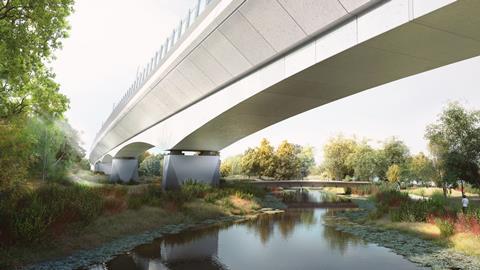
Among the notable features of the viaduct will be a series of transparent sidewall panels to give a view of the lakes from the train; early renderings of the structure suggest a high degree of cant to permit a line speed of around 320 km/h through a sweeping curve.
Preliminary piling works for the viaduct began earlier this year, with the first piles for a jetty to be bored by the end of June. This jetty will be used to support a mechanised rig from which the precast bridge elements will be projected across the water. The first of these elements are expected to be produced at South Portal before the end of the year.
HS2 Ltd believes the completed Colne Valley crossing will become the longest viaduct on the British main line network, surpassing the Tay Bridge near Dundee by around 100 m.



